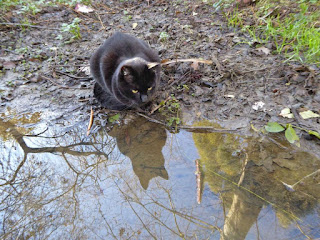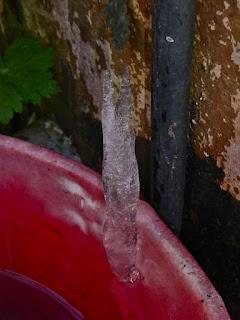Unfortunately this month finds us with our household a little smaller in number. Mr Smaug, who was my companion throughout the previous firing of this kiln, became very ill in the first week of October, and extensive tests by a really wonderful vet in Oamaru revealed that Mr Smaug had cancer and abnormalities through half of his gut. He had been full of his usually cheerfulness and good natured fun until a few days before I took him to the vet, and it was a shock to find how unwell he really was. I had him "put to sleep" whilst he was still somewhat under the effects of the anaesthetic that he had been given whilst having an ultrasound scan and other investigations. Naturally losing him was a severe blow, but we are so very thankful for the happy and delightful years that we shared together, he loved it when I was building something outside, or working on the kiln.
 |
Mr Smaug
|
As October draws to a close, I am very pleased to be able to report that about 10 days ago we had a successful stoneware firing of the wood-fired kiln. The firing was not entirely straightforward as I did manage to block up the firebox with embers when we had just past 1000 degrees, and this probably added nearly 3 hours to our firing time and a lot of extra wood was consumed due to things not being fired efficiently, but I am glad that we stuck with the firing and got it up to temperature as the results were very good.

I loaded the kiln slowly, doing it shelf by shelf over a period of nearly a month, and about 3 days before the firing I, possibly foolishly, decided to make some modifications to the Bourry box firebox that had only been fired one time previously. For various reasons, that included a shoulder tear, I didn't fully complete the modification, and this was the main cause of the problem with blocking the firebox with embers. Next firing, when the job has been fully done, should be easier!

Whilst I was fooling around with the modification, Jim, a new friend who wanted to learn about wood-fired kilns, visited and split lots of firewood for us, which was wonderful. I put a few of his pots in the kiln, two of them in the arch between firebox and the kiln chamber to see if they would get an "anagama" type treatment.
The day before the firing our friend Mark kindly helped install a stainless steel extension to the kiln chimney. This proved very successful, and the extra 3 feet definitely increased the flow of air through the kiln and allowed me to fire with only half to two thirds of the dampers open, and it was reassuring always having something extra available in reserve if we should need it.

On 18 October, I started the firing at 6.45am, a little later in the morning than I usually would, as I hoped to time things so that Jim could see the last hour or two of the firing after he finished work. We were fortunate with the weather, in that it was overcast and cool which made stoking the kiln less arduous.
As usual, the firing began with just a very small fire being lit on the floor of the firebox, and fed with a few twigs or thin pieces of split wood at a time. Over the course of about three and a half hours I gradually built up the fire and, when the temperature was at 350 degrees I started loading wood into the Bourry box hopper, and from that point onward, most of the stoking of the kiln by adding wood to the hopper and the fire-mouth that I had been tending the small fire through was gradually bricked up, to allow primary air to be drawn through the Bourry box, and further air through the "mouse-hole" below the ember bed.

Things appeared to be going very well indeed, with the rise in temperature being rapid until 900 degrees was reached, and then, unexpectedly, it started to taper off. After a really easy morning firing the kiln where I harboured some concern that I might finish the firing before Jim finished work, by early afternoon I began to have "dark thoughts" that the kiln would not get to temperature at all! It took me a little while to correctly diagnose why the kiln was sticking, but a proper look into the firebox after letting most of the Bourry box wood burn away, revealed that the firebox was so choked with embers that most of the archway into the kiln was obscured! I had to do some very hot work raking out about two bucket loads of incandescent embers, whilst still gently stoking the Bourry box.
 |
The archway from fire-box to kiln chamber that was obscured by embers!
|
We were fairly stuck for the best part of 3 hours, but started to make progress again at 3.45 in the afternoon. Fortunately Jim was able to arrive earlier than expected, and he was a great help splitting more firewood, and bringing it to me by the wheelbarrow load as I tried to coax the kiln out of the mire that it appeared to be in! I have only abandoned one firing, and this one came close to becoming number two! It was amazing how much wood was consumed due to the stoppage and the inefficiency, but we got there in the end. I stoked for about 12 hours in total, and it was 8pm in the evening when we had finally clammed up the kiln, made it safe for the night, and cleared up some of the mess. The shower I had after all that was very welcome!
We fired the kiln on a Tuesday and unpacked pots that were still gently warm to the touch late on Friday afternoon of that week.
 |
Jim's Pots
|
I was really delighted to see that Jim's pots were all very successful, he really deserved it after all his many hours splitting wood, and his two from the firebox arch were just like anagama pots with some nice natural wood ash glazing. He also had some lovely shino glazed pots in other parts of the kiln.
My pupil, Becky, had work in the kiln also, and most of that came out really well, it was lovely to get some though to glaze firing as she has done a lot of throwing with me on the wheel, but we are well behind with glazing her work due to my pace of work being rather slow over the last year or two for health reasons. She had some very nice goblets, bowls and jugs.
 |
| Becky with Goblets |
|
It had been interesting and difficult choosing glazes for that firing, as I was uncertain as to how well the kiln would perform to stoneware temperatures with all the changes that had been made. I selected glazes that I knew would mature over quite a wide range of temperature, and I anticipated that the top shelf would fire cooler than the ones below it, so glazes there were mostly capable of firing from about cone 6, to cone 9. On shelves further down in the kiln I looked at glazes that could be from cone 7 or 8 to cone 10 or 11.
In fact the kiln did manage to average about cone 9 or 10 through most of it (that would be about 1280 C or 2336 F in a fairly straightforward firing).
In spite of having difficulty controlling heat rise and the kiln atmosphere, I was very pleased to see that some celedon glazes and a copper red had worked very well.
I was lucky with that as these are glazes that usually require fairly careful firing to get a satisfactory result. Some sculptural work that I had done also turned out well, with a runny ash-type glaze giving almost a salt glazed effect to them.
October has been a month with plenty to celebrate, the kindness of friends and family, the excitement of a firing that finally worked well after a great struggle, and we are fortunate to have our lives enriched by memories of those we love who are no longer with us.
Walking With Mr Smaug
















Comments
It is much better to fire in a group..moral and physical support to each other!!
Looking forward to seeing you all soon!!!!!!xx
Good to hear from you. In the past I have mostly fired with just Laura and myself, and often on rainy days where we don't risk being interrupted, but it was wonderful to be able to have Jim helping this time around, he fitted in very well and his wood splitting really saved the day!
All the Best to you and the Pirate! xx